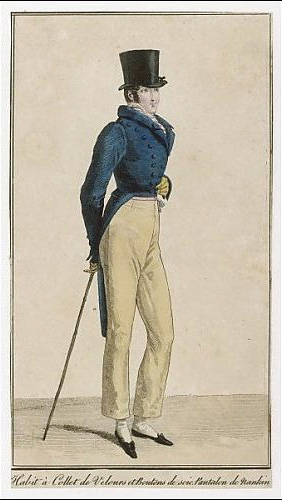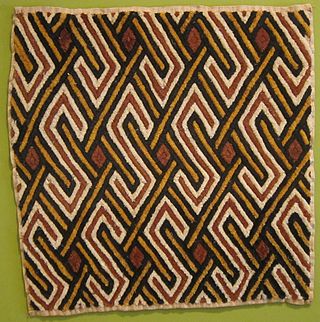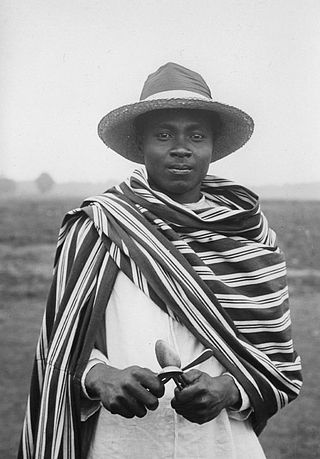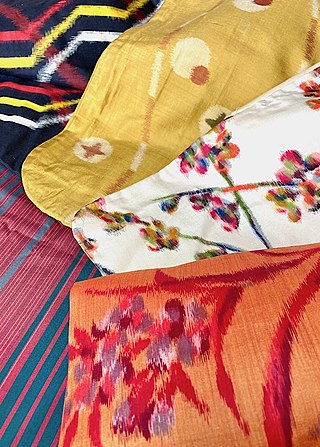
Calico is a heavy plain-woven textile made from unbleached, and often not fully processed, cotton. It may also contain unseparated husk parts. The fabric is far coarser than muslin, but less coarse and thick than canvas or denim. However, it is still very cheap owing to its unfinished and undyed appearance.

Weaving is a method of textile production in which two distinct sets of yarns or threads are interlaced at right angles to form a fabric or cloth. Other methods are knitting, crocheting, felting, and braiding or plaiting. The longitudinal threads are called the warp and the lateral threads are the weft, woof, or filling. The method in which these threads are interwoven affects the characteristics of the cloth. Cloth is usually woven on a loom, a device that holds the warp threads in place while filling threads are woven through them. A fabric band that meets this definition of cloth can also be made using other methods, including tablet weaving, back strap loom, or other techniques that can be done without looms.

Kente refers to a Ghanaian textile, made of handwoven cloth, strips of silk and cotton. Historically the fabric was worn in a toga-like fashion by royalty among the Akan. It originated from Bonwire in the Ashanti region of Ghana. In modern day Ghana, the wearing of kente cloth has become widespread to commemorate special occasions, with highly sought-after kente brands led by master weavers.
Ikat is a dyeing technique originating from Indonesia used to pattern textiles that employs resist dyeing on the yarns prior to dyeing and weaving the fabric.

Flannel is a soft woven fabric, of various fineness. Flannel was originally made from carded wool or worsted yarn, but is now often made from either wool, cotton, or synthetic fiber. Flannel is commonly used to make tartan clothing, blankets, bed sheets, and sleepwear.

Piqué, or marcella, refers to a weaving style, normally used with cotton yarn, which is characterized by raised parallel cords or geometric designs in the fabric. Piqué fabrics vary from semi-sheer dimity to heavy weight waffle cloth. Twilled cotton and corded cotton are close relatives.

Crêpe, also spelled crepe or crape is a silk, wool, or synthetic fiber fabric with a distinctively crisp and crimped appearance. The term "crape" typically refers to a form of the fabric associated specifically with mourning. Crêpe was also historically called "crespe" or "crisp".

Textile manufacturing is a major industry. It is largely based on the conversion of fibre into yarn, then yarn into fabric. These are then dyed or printed, fabricated into cloth which is then converted into useful goods such as clothing, household items, upholstery and various industrial products.

Bandhani is a type of tie-dye textile decorated by plucking the cloth with the fingernails into many tiny bindings that form a figurative design. The term bandhani is derived from the Sanskrit verbal root bandh. Today, most Bandhani making centers are situated in Gujarat, Rajasthan, Sindh, Punjab region and in Tamil Nadu where it is known as Sungudi. It is known as chunri in Pakistan. Earliest evidence of Bandhani dates back to Indus Valley civilization where dyeing was done as early as 4000 B.C. The earliest example of the most pervasive type of Bandhani dots can be seen in the 6th century paintings depicting the life of Buddha found on the wall of Cave 1 at Ajanta. Bandhani is also known as Bandhej Saree, Bandhni, Piliya, and Chungidi in Tamil and regional dialects. Other tying techniques include Mothra, Ekdali and Shikari depending on the manner in which the cloth is tied. The final products are known with various names including Khombi, Ghar Chola, Patori and Chandrokhani.

Nankeen is a kind of pale yellowish cloth originally made in Nanking, China from a yellow variety of cotton, but subsequently manufactured from ordinary cotton that is then dyed.

A palampore or (Palempore) is a type of hand-painted and mordant-dyed bed cover that was made in India for the export market during the eighteenth century and very early nineteenth century. Only the wealthiest classes could afford to buy palampore; therefore, the few examples that have survived are often quite valuable today. Palampore were primarily exported to Europe and to Dutch colonists in Indonesia and what was then called Ceylon.

Kasuri (絣) is the Japanese term for fabric that has been woven with fibers dyed specifically to create patterns and images in the fabric, typically referring to fabrics produced within Japan using this technique. It is a form of ikat dyeing, traditionally resulting in patterns characterized by their blurred or brushed appearance.
The manufacture of textiles is one of the oldest of human technologies. To make textiles, the first requirement is a source of fiber from which a yarn can be made, primarily by spinning. The yarn is processed by knitting or weaving, which turns yarn into cloth. The machine used for weaving is the loom. For decoration, the process of colouring yarn or the finished material is dyeing. For more information of the various steps, see textile manufacturing.

African textiles are textiles from various locations across the African continent. Across Africa, there are many distinctive styles, techniques, dyeing methods, and decorative and functional purposes. These textiles hold cultural significance and also have significance as historical documents of African design.

A woven coverlet or coverlid is a type of bed covering with a woven design in colored wool yarn on a background of natural linen or cotton. Coverlets were woven in almost every community in the United States from the colonial era until the late 19th century.

A lamba is the traditional garment worn by men and women that live in Madagascar. The textile, highly emblematic of Malagasy culture, consists of a rectangular length of cloth wrapped around the body.

Balinese textiles are reflective of the historical traditions of Bali, Indonesia. Bali has been historically linked to the major courts of Java before the 10th century; and following the defeat of the Majapahit kingdom, many of the Javanese aristocracy fled to Bali and the traditions were continued. Bali therefore may be seen as a repository not only of its own arts but those of Java in the pre-Islamic 15th century. Any attempt to definitively describe Balinese textiles and their use is doomed to be incomplete. The use of textile is a living tradition and so is in constant change. It will also vary from one district to another. For the most part old cloth are not venerated for their age. New is much better. In the tropics cloth rapidly deteriorates and so virtue is generated by replacing them.

Piece goods were the textile materials sold in cut pieces as per the buyer's specification. The piece goods were either cut from a fabric roll or produced with a certain length, also called yard goods. Various textiles such as cotton, wool, silk, etc., were traded in terms of piece goods. The prices were determined as per the fabric quality.

A tanmono is a bolt of traditional Japanese narrow-loomed cloth. It is used to make traditional Japanese clothes, textile room dividers, sails, and other traditional cloth items.

Meisen is a type of silk fabric traditionally produced in Japan; it is durable, hard-faced, and somewhat stiff, with a slight sheen, and slubbiness is deliberately emphasised. Meisen was first produced in the late 19th century, and became widely popular during the 1920s and 30s, when it was mass-produced and ready-to-wear kimono began to be sold in Japan. Meisen is commonly dyed using kasuri techniques, and features what were then overtly modern, non-traditional designs and colours. Meisen remained popular through to the 1950s.





















